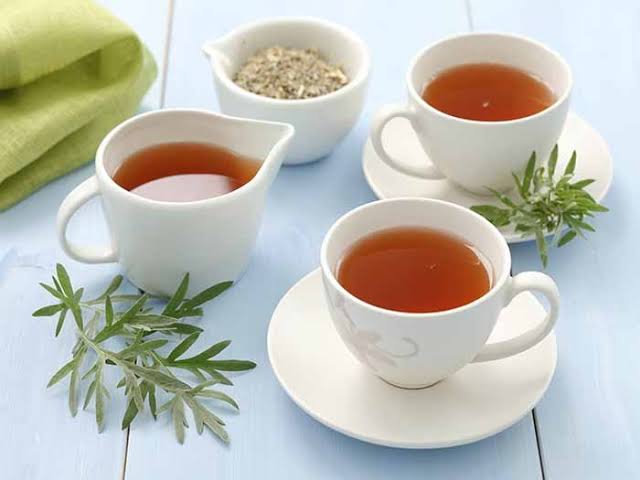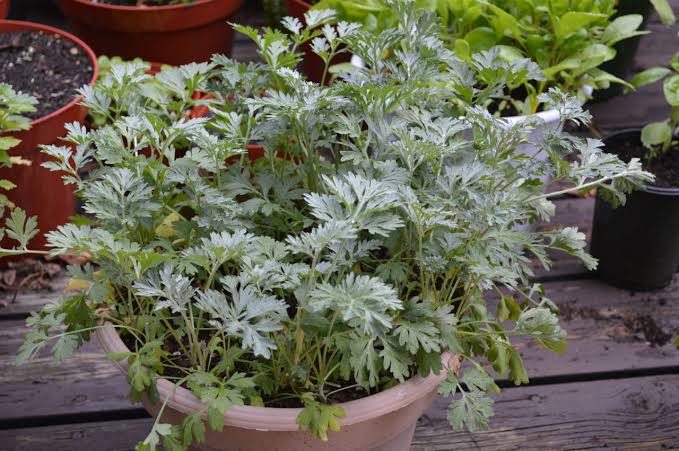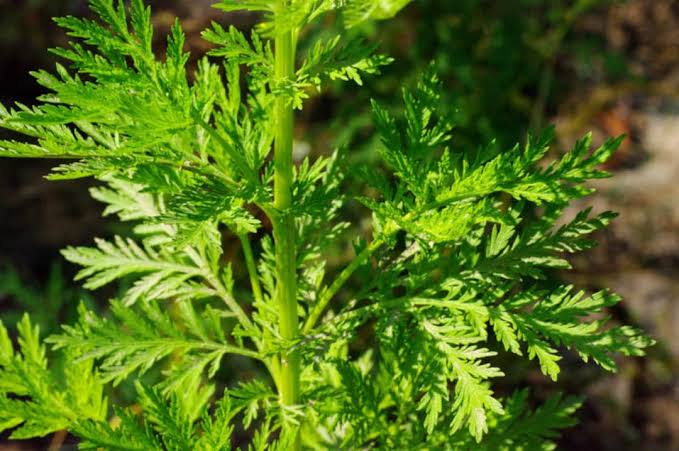Wormwood Tea is a wonderful beverage crafted from the leaves and flowers of the wormwood plant, scientifically known as Artemisia absinthium. This perennial herb belongs to the daisy family and has a rich history spanning across Europe, Asia, and North Africa.
The process of making Wormwood Tea is delightfully simple. To begin, you’ll require dried wormwood leaves and flowers, hot water, and a teapot or cup. The preparation involves measuring approximately 1-2 teaspoons of dried wormwood per cup of boiling water. After boiling the water and allowing it to cool slightly, you gently pour it over the dried wormwood.
The tea then steeps for 5-10 minutes, but this can be adjusted based on your preferred flavor strength. Finally, strain the tea to remove the plant material, and if desired, enhance the taste with honey, lemon, or other sweeteners and flavorings.
The flavor of Wormwood Tea is truly unique, described by some as a blend of bitterness and earthiness with underlying herbal notes. This bitterness primarily comes from compounds known as absinthin and anabsinthin. While not everyone may appreciate this bitterness, it lends character to the tea and can be balanced with the addition of sweeteners.
Wormwood Tea holds historical significance for its potential benefits. It has been traditionally used as a digestive aid, believed to stimulate appetite and improve digestion. Additionally, it contains antioxidants that may safeguard the body from harmful free radicals. Historically, wormwood has also been associated with enhancing mood and mental clarity. In some cultures, it has been used to combat intestinal parasites and as a mild sedative to promote relaxation and sleep.
However, it is important to exercise caution with Wormwood Tea. The bitterness might not be suitable for everyone, and excessive consumption can be harmful due to the presence of thujone, a potentially toxic compound. Pregnant or breastfeeding individuals should avoid wormwood, and those with allergies to this herb should exercise caution.
In addition, Wormwood Tea is a unique herbal infusion with a rich history and potential health benefits. It offers a distinctive flavor profile that may require an acquired taste. When considering Wormwood Tea, consult with a healthcare professional, particularly if you have underlying health conditions or are taking medications. Enjoy this herbal brew in moderation, savoring its uniqueness and potential advantages while being mindful of its bitterness and thujone content.
Read Also: Potential Food Safety Hazards and Control Measures
13 Health Benefits of Wormwood Tea

Here are 13 potential health benefits associated with Wormwood Tea:
1. Digestive Aid: Wormwood Tea may help relieve indigestion and stimulate appetite, making it useful for digestive discomfort.
2. Antioxidant Properties: It contains antioxidants that can combat free radicals in the body, potentially reducing oxidative stress.
3. Mood Support: Historically, wormwood has been linked to improving mood and promoting mental clarity.
4. Parasite Elimination: Some cultures have used wormwood to address intestinal parasites and infections.
5. Mild Sedative: In certain instances, Wormwood Tea has been used as a mild sedative to induce relaxation and enhance sleep quality.
6. Anti-Inflammatory: Wormwood possesses anti-inflammatory properties, which may help reduce inflammation and associated discomfort.
7. Stomach Cramp Relief: It can potentially alleviate stomach cramps and discomfort, offering relief from gastrointestinal issues.
8. Liver Support: Wormwood is believed to aid liver health and function, helping the body detoxify more effectively.
9. Gallbladder Health: It may assist in maintaining gallbladder health by preventing gallstones and promoting proper bile flow.
10. Improved Appetite: Wormwood Tea’s bitter taste can stimulate appetite, potentially aiding in weight gain for those with a poor appetite.
11. Menstrual Pain Relief: Some women have found relief from menstrual pain and discomfort by consuming Wormwood Tea.
12. Respiratory Health: Wormwood’s anti-inflammatory properties might help soothe respiratory issues such as coughs and bronchitis.
13. Skin Health: Topical applications of wormwood may help alleviate skin conditions like eczema and psoriasis when used in moderation.
While these potential benefits are intriguing, it’s essential to use Wormwood Tea cautiously and in moderation due to its bitter taste and the presence of thujone, a potentially toxic compound. If you’re considering using Wormwood Tea for its potential health benefits, it’s advisable to consult with a healthcare professional to ensure it’s suitable for your specific needs and to determine the right dosage.
How to Grow the Wormwood Tea Plant

Growing a wormwood tea plant, scientifically known as Artemisia absinthium, can be a rewarding endeavor. Below is a step-by-step guide on how to grow this herb:
1. Choose the Right Location: Select a sunny spot in your garden with well-draining soil. Wormwood thrives in full sunlight, so ensure it gets at least 6-8 hours of direct sunlight per day.
2. Obtain Wormwood Seeds or Cuttings: You can start wormwood from seeds or cuttings. Seeds can be sown directly in the garden or started indoors in pots. Alternatively, you can obtain cuttings from an existing wormwood plant.
3. Soil Preparation: Wormwood prefers soil that is moderately fertile and well-draining. You can improve drainage by adding sand or perlite to the soil. Ensure the soil has a slightly alkaline to neutral pH level.
4. Planting Seeds or Cuttings: If planting seeds, sow them on the soil surface and lightly press them down. Water gently after planting. If using cuttings, plant them in prepared holes, water thoroughly, and provide them with a well-draining environment.
5. Spacing: Space wormwood plants about 2-3 feet apart to allow for their mature size. Wormwood can grow up to 3 feet in height and width.
6. Watering: Wormwood is drought-tolerant and doesn’t require frequent watering. Water sparingly, allowing the soil to dry out between waterings. Overwatering can lead to root rot.
7. Pruning: Prune the plant regularly to encourage bushy growth and to prevent it from becoming too leggy. You can trim it back in the spring to promote new growth.
8. Harvesting: You can start harvesting the leaves and flowers once the plant is established, typically in its second year. Harvest in the morning when the essential oils are at their peak. Cut the stems, leaving some leaves behind for regrowth.
9. Drying: To make wormwood tea, dry the harvested leaves and flowers. Spread them out in a well-ventilated area out of direct sunlight. Once thoroughly dry, store them in an airtight container for future use.
10. Pest and Disease Control: Wormwood is relatively resistant to pests and diseases. However, keep an eye out for aphids, spider mites, and powdery mildew. Use appropriate organic remedies if needed.
11. Winter Care: Wormwood is hardy in many regions and can withstand cold winters. However, in extremely cold climates, you may want to provide some winter protection with mulch or by moving potted plants indoors.
12. Propagation: Wormwood can be propagated by division or from cuttings if you want to expand your plant collection.
Remember that wormwood contains thujone, which can be toxic in high quantities. When making tea from your homegrown wormwood, use a moderate amount of leaves and flowers, and consult with a healthcare professional if you have any concerns about its safety or dosage.
Read Also: Guide to Proper Storage of Farm Produce and the Role of Storage in the Economy
Sweet Wormwood

Sweet Wormwood is a kind of plant that has some good uses. People use it for many things, and it can help with some health issues.
Sweet Wormwood, also called Artemisia annua, is a plant that grows in many places around the world. It’s been used for a very long time in traditional medicine. People often call it “sweet” because it has a bit of a sweet taste when you chew the leaves.
How People Use Sweet Wormwood
1. Malaria Fighter: Sweet Wormwood is famous for fighting malaria, a sickness that comes from mosquito bites. People use a part of the plant to make medicine that can help treat malaria. This is very important, especially in places where malaria is common.
2. Feeling Better: Some folks use Sweet Wormwood when they feel sick. They believe it can help with fever, headaches, and feeling bad.
3. In the Garden: Gardeners also like Sweet Wormwood. They grow it because it can keep away pests from other plants. It’s like having a natural protector in the garden.
4. Tea Time: People make tea from Sweet Wormwood leaves. They say it can help with digestion and make you feel better inside.
How to Use Sweet Wormwood Safely
While Sweet Wormwood has some good uses, it is important to be very careful:
1. Dosage Matters: If you want to use it for health reasons, talk to a doctor or an expert. Using too much Sweet Wormwood can be harmful.
2. Pregnancy and Kids: Pregnant women and very young kids should be extra careful and not use Sweet Wormwood without asking a healthcare expert.
3. Other Medicines: If you take other medicines, Sweet Wormwood might not be safe to use with them. Make sure to check with a healthcare professional.
4. Allergies: Some people might be allergic to Sweet Wormwood, so watch out for any bad reactions.
Sweet Wormwood is a plant with a sweet name and a lot of good uses. People use it for fighting malaria, feeling better when they’re sick, and even protecting their gardens. But remember, it’s important to be careful when using it for health reasons and to talk to a healthcare expert if you’re not sure. Sweet Wormwood might be sweet, but it’s always best to be safe.
Read Also: TV Wastes (Old Television) Best Money Making Methods
